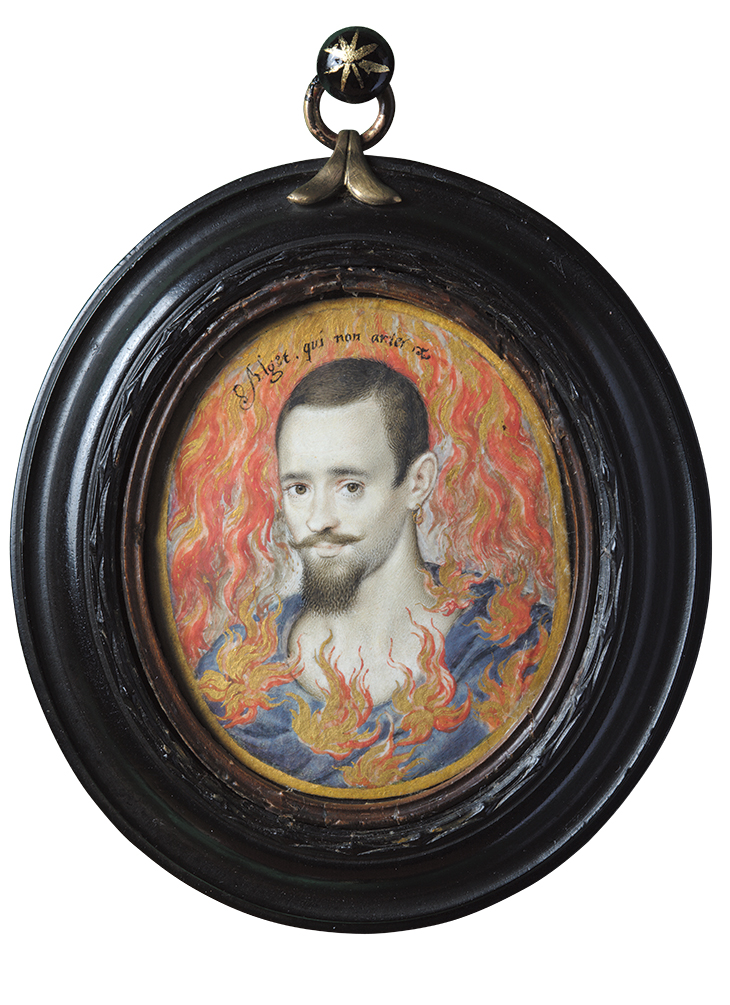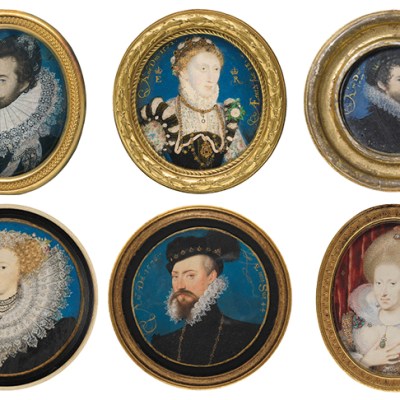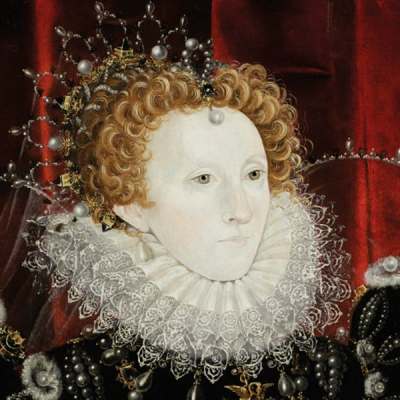Isaac Oliver’s A Man Consumed by Flames (c. 1600–10) is one of the most admired and intriguing portrait miniatures of the English Renaissance. It depicts a man bust-length, clad in a blue mantle of classical style and sporting a carefully groomed moustache, a spade beard and a ring of curled gold in his left ear. His neatly parted yet receding hair frames a high forehead, indicative of the serene intelligence with which he gazes at the viewer from hazel eyes, fringed by delicately picked-out eyelashes. He seems unperturbed by the bursts of orange and gold flame that engulf him, offset against the marble-like tone of his smooth skin, delicately modelled in Oliver’s distinctive stippling technique. While alluding to the ancient busts that were increasingly fashionable in Jacobean England, the man is no statue: a slight smile graces his lips and there are subtle hints of warmth in the carnation of his flesh. Thus, the miniature invites a series of paragoni (comparisons), between sculpture and painting, animacy and inertness, hot and cold. Indeed, as its motto proclaims in an elegant cursive script, Alget, qui non ardet: ‘He grows cold, who does not burn.’ But burn with what?
A Man Consumed by Flames (c. 1600–10), Isaac Oliver. Ham House, Surrey. Photo: Ⓒ National Trust/Christopher Warleigh-Lack

It has long been assumed that the man is a lover, consumed by the flames of profane amor, his picture a gift of passionate devotion to a beloved. He is often compared to an earlier miniature, by Oliver’s tutor Nicholas Hilliard, of a half-length man in an open undershirt, similarly surrounded by flames while holding at his breast a locket, presumably containing a miniature of a loved one. Miniatures were frequently exchanged by Elizabethan and Jacobean elites as tokens of affection between friends, family members and lovers, in a milieu that favoured the poetics of chivalric romance and courtly love. This was the era of the Petrarchan love lyric and Shakespeare’s sonnets – verses rich in allusion and conceit, with sudden reversals and hidden meanings. So-called impresa miniatures, such as A Man Consumed by Flames, responded to this aesthetic. As George Puttenham explained in The Arte of English Poesie (1589), an impresa was:
[…] the short, quicke and sententious propositions, such as be at these dayes all your devices of armes and other amorous inscriptions which courtiers use to give and also to weare in liverie for the honour of their ladies, and commonly containe but two or three words of wittie sentence or secrete conceit till they [are] unfolded or explaned by some interpretatio[n]. For which cause they be commonly accompanied with a figure or purtraict of ocular representation, the words so aptly corresponding to the subtilitie of the figure, that aswel the eye is therwith recreated as the eare or the mind. The Greekes call it Emblema, the Italiens Impresa, and we, a Device, such as a man may put into letters of gold and sende to his mistresses for a token […]
Unknown Young Man against a Background of Flames (c. 1600), Nicholas Hilliard. Victoria and Albert Museum, London

Understood in this context as an amatory gift, our man is like a salamander among the flames, fuelled but unhurt by the fires of love. As the emblem ‘Love liveth by fire’ in Otto van Veen’s Amorum Emblemata (1608) explains:
Unhurt amidst the fire the Salamander lives,
The lover in the fire of love delight doth take,
Where love thereby to live his nouriture doth make,
What others doth destroy life to the lover gives.
But what if the miniature’s fire and motto have a different meaning? Renaissance critics agreed that what differentiated an impresa from an emblem was the personal specificity of its meaning. Emblems represented commonplaces, applicable to all kinds of people and circumstances, whereas an impresa, as the antiquarian William Camden observes, was ‘borne by noble and learned personages, to notify some particular conceit of their own’. To understand the meaning of Alget, qui non ardet, we need to know who the man is.
Hitherto, the man among flames has remained stubbornly unidentified, but new evidence suggests he may be William Strachey (1572–1621), one of the early Virginia colonists, whose account of being shipwrecked on Bermuda is widely thought to have informed Shakespeare’s The Tempest. Shortly after his return to England from Virginia in the autumn of 1611, Strachey published a short pamphlet setting out the laws of the Virginia colony that had been introduced by its then-governor, Lord De La Warr. The title page of For the Colony in Virginea Britannia. Lawes Divine, Morall & Martiall etc. (1612) bears the motto Alget qui non ardet. Not only was this the first time this exceptionally rare motto had appeared in print, Strachey also used it in an eyewitness account of Virginia that he hoped would make his name, The Historie of Travaile into Virginia-Britania (c. 1612). A presentation copy of the manuscript now in the Bodleian Library (MS Ashmole 1758), dedicated to Sir Allen Apsley, purveyor to the King’s Navy, bears the motto on the title pages of its first and second books. As we shall see, if Strachey is the man among flames, his motto refers not to the ardour of a lover but to the Protestant zeal of the colonist-cum-missionary.
‘Mea Vita per Ignem’, from Amorum Emblemata (1608) by Otto van Veen. Image: The Book Worm/Alamy Stock Photo

Strachey is a prime candidate for commissioner of an impresa miniature. Born into the provincial gentry of Saffron Walden, he studied briefly at Cambridge before enrolling at Gray’s Inn in London. Leaving his wife behind, like many young men of the Inns of Court he spent little time at his law books, preferring instead to frequent the playhouse and carouse with poets, living off the income of a country estate inherited from his father. Strachey seems to have been a member of the infamous ‘Mermaid Club’ of rakish wits, named after the Mermaid Tavern on Cheapside, which hosted drunken meetings of the so-called ‘Fraternity of Sireniacal Gentleman’. The club’s leading light, Ben Jonson, published a prefatory poem by Strachey in Sejanus His Fall (1605), first performed by Shakespeare and the King’s Men in 1603. Coincidentally, several of its lines prefigure Strachey’s fate at the hands of a devastating storm:
And as lightning comes behind the thunder
From the torn cloud, yet first invades our sense,
So every violent fortune, that to wonder
Hoists men aloft, is a cleere evidence
Of a vaunt-curring blow the fates have given.
John Donne, another member of the club (portrayed by Isaac Oliver in 1616; Royal Collection), wrote on Strachey’s behalf when he tried and failed to obtain a position with the English ambassador in Venice, while Thomas Campion – a friend at Gray’s Inn – composed a short Latin verse in Strachey’s honour. Strachey was evidently considered a poet in his own right, albeit his ample funds likely encouraged professional wordsmiths artificially to inflate his literary talent.
In fact, Strachey had a financial stake in the world of letters, owning a share in the company of child players – the Children of the Revels – who performed at the Blackfriars theatre, owned by Richard Burbage. It is quite conceivable that through this connection Strachey would have met Burbage’s fellow player, Shakespeare. As the income from his estate started to wane, Strachey sought fresh ventures to renew his capital. After a disastrous stint as secretary to the English ambassador to Constantinople, Sir Thomas Glover, he purchased a share in the Virginia Company and set sail for the English colony in the summer of 1609. Seven ships (towing two additional pinnaces) bearing between 500 and 800 colonists set out from Plymouth, with Strachey aboard the Sea Venture, a 300-ton vessel captained by Christopher Newport, which also bore Sir Thomas Gates, who was to be governor of the colony.
On 24 July, after some six weeks at sea, there arose (as Strachey put it) ‘a most dreadfull tempest’ that ‘began to blow from out the North-east, which swelling, and roaring as it were by fits, some houres with more violence then others, at length did beate all light from heaven; which like an hell of darkenesse turned blacke upon us.’ The convoy was separated, and each ship steered its own course for Virginia. Six came limping into Jamestown, damaged and having lost men, but of the Sea Venture there was no sign. Strachey later recounted the saga in A True Reportory of the Wracke, and Redemption of Sir Thomas Gates, Knight; upon, and from the Ilands of the Bermudas, written in Virginia in the summer of 1610 and sent as a letter to an ‘Excellent Lady’ in England later that year. Although it was not published until much later, in Samuel Purchas’s collection of voyages Purchas his Pilgrimes (1625), Strachey’s letter is thought to have circulated in manuscript in London, where it very likely came to the attention of Shakespeare, perhaps already writing The Tempest, which was first performed in November 1611. Swept away in the storm, the Sea Venture sprung a ‘mighty leake’, which the crew spent days and nights desperately working to fix, straining ‘with tyred bodies, and wasted spirits’ to keep the damaged ship afloat. During this time, Strachey says, the sky was so thunderously dark that ‘it was not possible the elevation of the Pole might be observed: nor a starre by night, nor sunne beame by day’. Thus oppressed by storm clouds, Strachey recounts the mariners’ wonder at a fiery apparition: a ‘sparkeling blaze, halfe the height upon the maine mast, and shooting sometimes from shroud to shroud’. This description of the natural marvel ‘St Elmo’s Fire’ may have inspired Ariel’s account in The Tempest (act one, scene two) of wrecking The Prince Royal at Prospero’s command:
I boarded the king’s ship; now on the beak,
Now in the waist, the deck, in every cabin,
I flamed amazement: sometime I’d divide,
And burn in many places – on the topmast,
The yards and bowsprit, would I flame distinctly,
Then meet and join.
Having pumped for days on end, close to sinking and abandoning hope, the crew of the Sea Venture finally sighted land. The ship was run aground and the mariners made it safely to shore, only to discover they had been beached on ‘the dangerous and dreaded Iland, or rather Ilands of the Bermuda’. Yet despite Bermuda’s reputation as a barren, uninhabitable place, Strachey recounts how the castaways prospered there, describing in detail the archipelago’s flora and fauna, and the eventual construction of pinnaces by which the survivors made their way to Virginia, entering Chesapeake Bay in spring 1610.
Detail of a map of Bermuda from 1640, printed by William Janzon Blaeu, showing the Sea Venture crashing on rocks. Mariners’ Museum, Newport News, VA

In Jamestown, Strachey became secretary to the colony, which had been much reduced by famine, disease and raids by the local Native American population during the so-called ‘Starving Time’ of winter 1609–10. Yet under the governance of De La Warr and Gates, the colony began to revive, with new fortifications, successful planting and increased trade. News of this success trickled back to London, to the relief of the Virginia Company and its investors, fuelling the fires of enthusiasm for this colonial venture. In December 1610 the Secretary of the Company, Richard Martin, wrote from London to Strachey in Jamestown, praising the colonists’ efforts and encouraging them to greater achievements:
If you know good Mr Strachey, the care that I have of this plantacon, the travel that I have taken therein … and the fire that doth not onlie burne in mee, but flames out to the view of every one, for the furtherance of this honorable enterprise, you wolde thinke that my speech hath neither fashion nor purpose of a complement.
Perhaps this, then, is the fire of A Man Consumed by Flames: the fervent flame of the colonist, eager for enrichment from a new world and piously seeking the conversion of its – in their eyes – Caliban-like natives to the Christian (more specifically, Protestant) faith. As Strachey put it in verses prefacing The Historie of Travaile into Virginia-Britania:
Wild as they are, accept them, so we’re wee
To make them civill, will our honnour bee
And if good worcks be the effects of mindes,
Which like good angels be, let our designes,
As wee are Angli, make us Angells too:
No better worck can state- or church-man do.
Yet can we be sure the man Oliver portrayed is Strachey, of whom no certain likenesses exist? The miniature is undated, but scholars have placed it anywhere from c. 1600 to c. 1610. Roy Strong has argued for the later date on the grounds that its ‘antique’ manner, in particular the classical mantle the sitter wears, accords with other miniatures Oliver made around this time, such as his portrait of Henry, Prince of Wales (1610), as well as pictures in large by the limner’s brother-in-law, Marcus Gheeraerts the Younger. Strachey returned to London from Virginia in late 1611, lodging in the Blackfriars, where he counted Isaac Oliver among his neighbours. Strachey’s background, use of the motto, and life experiences all point to him as the likely sitter, but at the age of 40 in 1612, is he too old to be the man consumed by flames? Oliver was not averse to portraying his sitters in their best light (for example, his miniature of Ludovic Stewart, 2nd Duke of Lennox; Fitzwilliam Museum), and in any event, Strachey might have commissioned the portrait before he set out for Virginia in 1609. Yet there is a further twist, in that Strachey was not the sole member of the Virginia Company to use the motto Alget, qui non ardet. While its fiery theme was deployed by others, such as Richard Martin, to express their all-consuming enthusiasm for the colonial enterprise, the motto also appeared in print – to the best of my knowledge, the only other time it did so – on the title page of Ralph Hamor’s A True Discourse of the Present Estate of Virginia (1615). Hamor (1589–1626) was Strachey’s successor as secretary to the Virginia colony and had, like him, been a member of the ill-fated voyage of 1609. Although not mentioned by name in any of the accounts of the shipwreck, he seems to have been aboard the Sea Venture, for in his book he mentions the ‘miraculous delivery of the scattered company, cast upon the Bermudas […] which received our wrackt company’. Yet Hamor stayed in Virginia until 1615, sailing home to England before returning to the colony in 1617, where he died nine years later. Given the likely date of Oliver’s miniature, it is improbable that it depicts Hamor, who might simply have imitated Strachey, his predecessor as secretary, by copying his motto. Maybe the motto Alget, qui non ardet circulated more widely in Virginia Company circles, perhaps being used by survivors from the Sea Venture. Yet unless and until evidence comes to light of a plausible alternative, Strachey remains the best candidate for the sitter in Oliver’s miniature.
Despite repeated attempts to gain patronage through his Historie of Travaile, copies of which were dedicated unsuccessfully to Henry Percy, 9th Earl of Northumberland, and Sir Francis Bacon, Strachey’s fortunes waned after he returned from Virginia. Back in England, perhaps resuming his old spendthrift ways, he quickly fell into debt, and his final years were spent in obscurity. A commonplace book compiled towards the end of his life indicates that his thoughts turned more and more to religion. He continued to write poetry, now in a pious vein:
All manner sinnes, all manner ways
I have committed in my daies
Hell and hell fire is my due
O but dear Christe I humbly sue
Unknown Melancholy Young Man (c. 1595–1610), Isaac Oliver. The Portland Collection, Harley Gallery, Welbeck Estate, Nottinghamshire. Image: Bridgeman Images

Oliver’s A Man Consumed by Flames, whether Strachey or not, is a salient reminder that sacred rather than profane love was often uppermost in the minds of the elite men and women of Renaissance England. It should be placed in the company of other miniatures once thought to depict melancholic lovers, but which are surely better understood as images of devotion. One such picture is Oliver’s so-called Unknown Melancholy Young Man (c. 1595–1610), possibly a portrait of William Browne (1577/8–1637), youngest of the recusant Three Brothers Browne depicted by Oliver in 1598. Naked, gazing heavenward and with arms crossing his chest in a gesture of devotion, he poses against a seascape in which a storm-tossed ship runs close by a rock. This rock may have been intended as a symbol of constancy, although a comparison of the miniature with an emblematic depiction of the Sea Venture’s wrecking shows it could equally refer to fate: the motto Quo fata ferunt (‘Whither fate carries us’) features in Bermuda’s coat of arms from at least 1624. This young man’s steadfastness or resignation to fate is not that of the profane lover, bound to his beloved, but of the sacred one – loyally committed in this case (since the portrait surely derives from images of the penitent Magdalen) to Catholicism. The fire of faith burns in the breast of this young religioso, where in Strachey’s portrait it is externalised. William Strachey’s fiery zeal is a symbol of devotion to God and the Protestant evangelical mission, shining forth in a portrait miniature worn close to the heart: Alget, qui non ardet.
From the September 2020 issue of Apollo. Preview and subscribe here.


